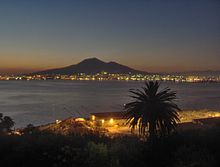This is an old revision of this page, as edited by 65.18.68.175 (talk) at 16:39, 4 March 2008 (→Physical appearance). The present address (URL) is a permanent link to this revision, which may differ significantly from the current revision.
Revision as of 16:39, 4 March 2008 by 65.18.68.175 (talk) (→Physical appearance)(diff) ← Previous revision | Latest revision (diff) | Newer revision → (diff) This article is about the mountain in Italy. For Vesuvius (disambiguation), see Mount Vesuvius (disambiguation).| Mount Vesuvius | |
|---|---|
| Highest point | |
| Elevation | 1,281 m (4,203 ft) |
| Prominence | 1,232 m (4,042 ft) |
Mount Vesuvius (Italian: Monte Vesuvio, Latin: Mons Vesuvius) is a stratovolcano east of Naples, Italy. It is the only volcano on the European mainland to have erupted within the last hundred years, although it is not currently erupting. The two other volcanoes in Italy (Etna and Stromboli) are located on islands.
Vesuvius is on the coast of the Bay of Naples, about nine kilometres (six miles) east of Naples and a short distance from the shore. It is conspicuous in the beautiful landscape presented by the Bay of Naples, when seen from the sea, with Naples in the foreground. Vesuvius is best known for its eruption in AD 79 that led to the destruction of the Roman cities of Pompeii and Herculaneum. It has erupted many times since and is today regarded as one of the most dangerous volcanoes in the world because of the population of 3,000,000 people now living close to it and its tendency towards explosive eruptions. It is the most densely populated volcanic region in the world.
Mount Vesuvius was regarded by the Greeks and Romans as being sacred to the hero and demigod Heracles/Hercules, and the town of Herculaneum, built at its base, was named after him.
Physical appearance

Vesuvius is a distinctive "humpbacked" mountain, consisting of a large cone (Gran Cono) partially encircled by the steep rim of a summit caldera caused by the collapse of an earlier, and originally much higher structure called Monte Somma. The Gran Cono was produced during the eruption of 79. For this reason, the volcano is also called Somma-Vesuvius or Somma-Vesuvio.
The caldera started forming during an eruption around 17,000 (or 18,300) years ago and was enlarged by later paroxysmal eruptions ending in the one of 79. This structure has given its name to the term "somma volcano", which describes any volcano with a summit caldera surrounding a newer cone.
The height of the main cone has been constantly changed by erections but presently is 1,281 m (4,202 ft). Monte Somma is 1,149 m (3,770 ft) high, separated from the main cone by the valley of Atrio di Cavallo, which is some 3 miles (5 km) long. The slopes of the mountain are scarred by lava flows but are heavily vegetated, with scrub at higher altitudes and vineyards lower down. Vesuvius is still regarded as an active volcano, although its current activity produces little more than steam from vents at the bottom of the crater. Vesuvius is a stratovolcano at the convergent boundary where the African Plate is being subducted beneath the Eurasian Plate. Its lava is composed of viscous andesite. Layers of lava, scoria, volcanic ash, and pumice make up the mountain.
Formation

Vesuvius was formed as a result of the collision of two tectonic plates, the African and the Eurasian. The former was pushed beneath the latter, deeper into the earth. The crust material became heated until it melted, forming magma, a type of liquid rock. Because magma is less dense than the solid rock around it, it was pushed upward. Finding a weak place at the Earth's surface it broke through, producing the volcano.
The volcano is one of several which form the Campanian volcanic arc. Others include Campi Flegrei, a large caldera a few kilometres to the north west, Mount Epomeo 20 kilometers to the west on the island of Ischia, and several undersea volcanoes to the south. The arc forms the southern end of a larger chain of volcanoes produced by the subduction process described above, which extends northwest along the length of Italy as far as Monte Amiata in Southern Tuscany. Vesuvius is the only one to have erupted within recent history, although some of the others have erupted within the last few hundred years. Many are either extinct or have not erupted for tens of thousands of years.
Vesuvius today
The area around Vesuvius was officially declared a national park on 5 June 1995. The summit of Vesuvius is open to visitors and there is a small network of paths around the mountain that are maintained by the park authorities on weekends.
There is access by road to within 200 metres of the summit (measured vertically), but thereafter access is on foot only. There is a spiral walkway around the mountain from the road to the crater.
- "Summary of the eruptive history of Mt. Vesuvius". Osservatorio Vesuviano, Italian National Institute of Geophysics and Volcanology. Retrieved 2006-12-08.
- "The Pomici Di Base Eruption". Osservatorio Vesuviano, Italian National Institute of Geophysics and Volcanology. Retrieved 2006-12-08.
- Vesuvius, Italy, Volcano World
- The world's top volcanoes, Scentia
- "Vesuvius". Global Volcanism. Retrieved 2006-12-08.
- "Definition of somma volcano". Volcano Live. Retrieved 2006-12-11.
- Vesuvius portal website